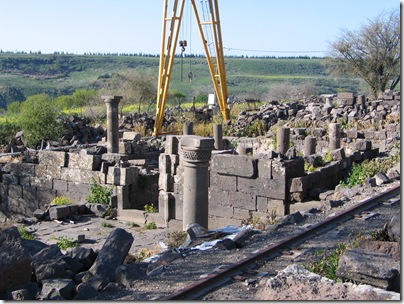Scientists have just released a report on a massive earthquake in 749 A.D. in Israel. The Jerusalem Post article is misleading in suggesting that they just now learned about this particular earthquake, as any visitor to Beth Shean will attest when viewing the fallen columns. But some more information has been learned based on excavations at Umm el-Kanater in the Golan Heights.
The discovery by Tel Aviv University scientists that a major earthquake (over 7 on the Richter scale) took place on the Golan Heights in the year 749 CE – and none of similar magnitude in some 975 years – means the area is long overdue for another one. So say the TAU geologists and archeologists who published their findings in Seismology Research Letters released to the press on Sunday.
The archeological signs of the earthquake were found at Umm el-Kanater (“Mother of the Arches”), a five- or 10-minute drive from Katzrin and near Moshav Natur east of the Kinneret. The damage consisted of a broken pool of water whose two parts were moved a meter from one another. The pools had been used to collect water for a nearby village inhabited from the Byzantine Period until the middle of the eighth century. The dig site has been open to the public for more than three years.
The village suffered destruction, including damage to an elaborately built synagogue that collapsed and whose stones were fortunately not stolen, unlike those of many other archeological sites on the Golan.
You can read the rest at the Jerusalem Post.
The reference to 975 years is enigmatic. It probably is a reference to an earthquake in 1724 A.D., but why that means Israel is due for another one at this time is not clear.
